HSNS273 Report: Polycystic Ovary Syndrome (PCOS) Analysis
VerifiedAdded on 2022/10/17
|8
|1726
|22
Report
AI Summary
This report examines Polycystic Ovary Syndrome (PCOS), a complex endocrine disorder characterized by hyperandrogenism, menstrual irregularities, and often, polycystic ovaries. The assignment analyzes a case study of a 26-year-old female with a history of PCOS, focusing on the pathophysiology of the condition, including insulin resistance, hormonal imbalances, and the role of androgens. It details diagnostic assessments such as physical examinations, pelvic exams, ultrasounds, and blood tests used to identify PCOS. Furthermore, the report explores pharmacological treatments, including birth control pills and progestin therapy, aimed at managing symptoms like irregular periods, acne, and hirsutism. The report emphasizes the importance of lifestyle changes and highlights the potential long-term health risks associated with PCOS, such as type 2 diabetes and cardiovascular disease, advocating for holistic patient care and awareness among healthcare providers.
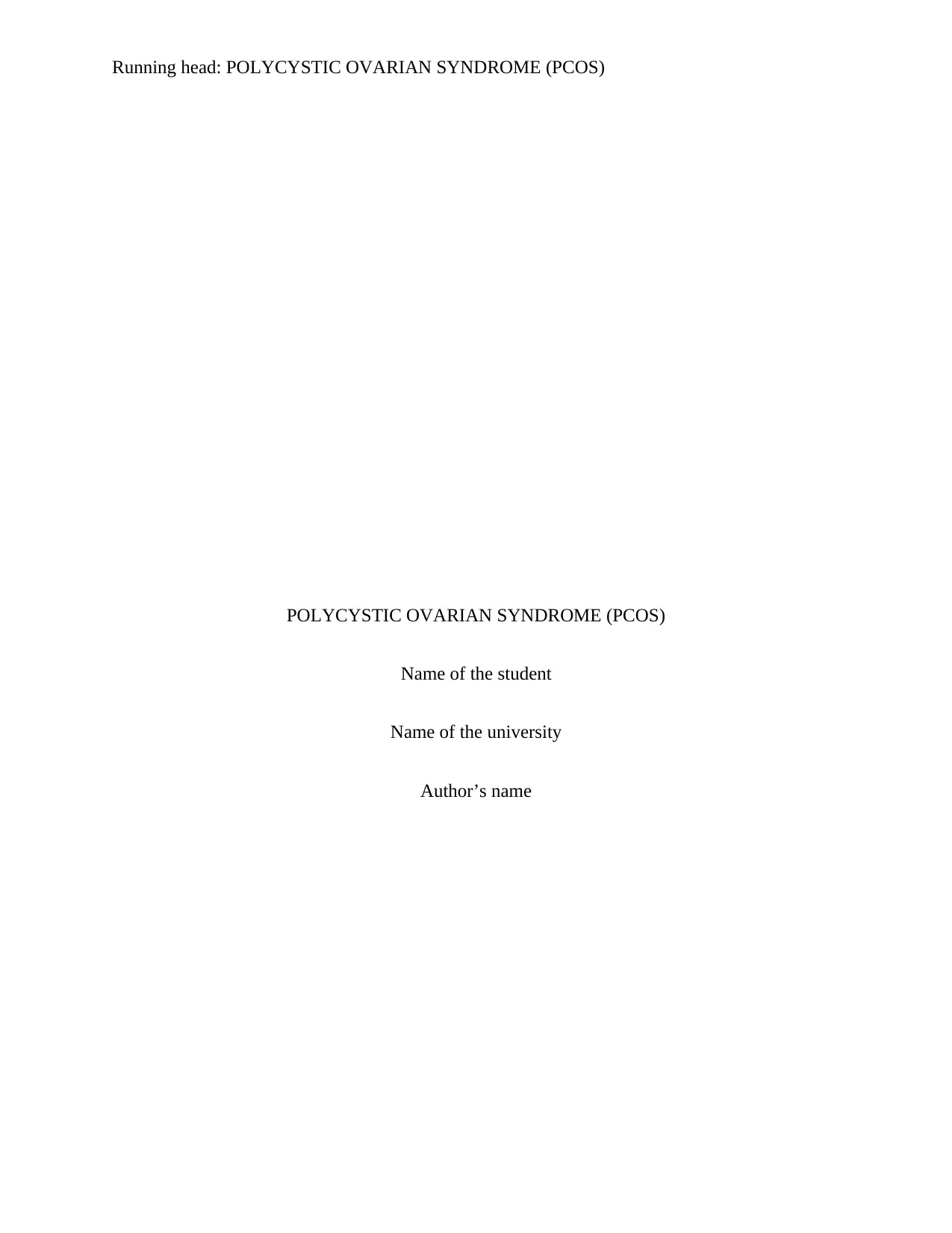
Running head: POLYCYSTIC OVARIAN SYNDROME (PCOS)
POLYCYSTIC OVARIAN SYNDROME (PCOS)
Name of the student
Name of the university
Author’s name
POLYCYSTIC OVARIAN SYNDROME (PCOS)
Name of the student
Name of the university
Author’s name
Paraphrase This Document
Need a fresh take? Get an instant paraphrase of this document with our AI Paraphraser
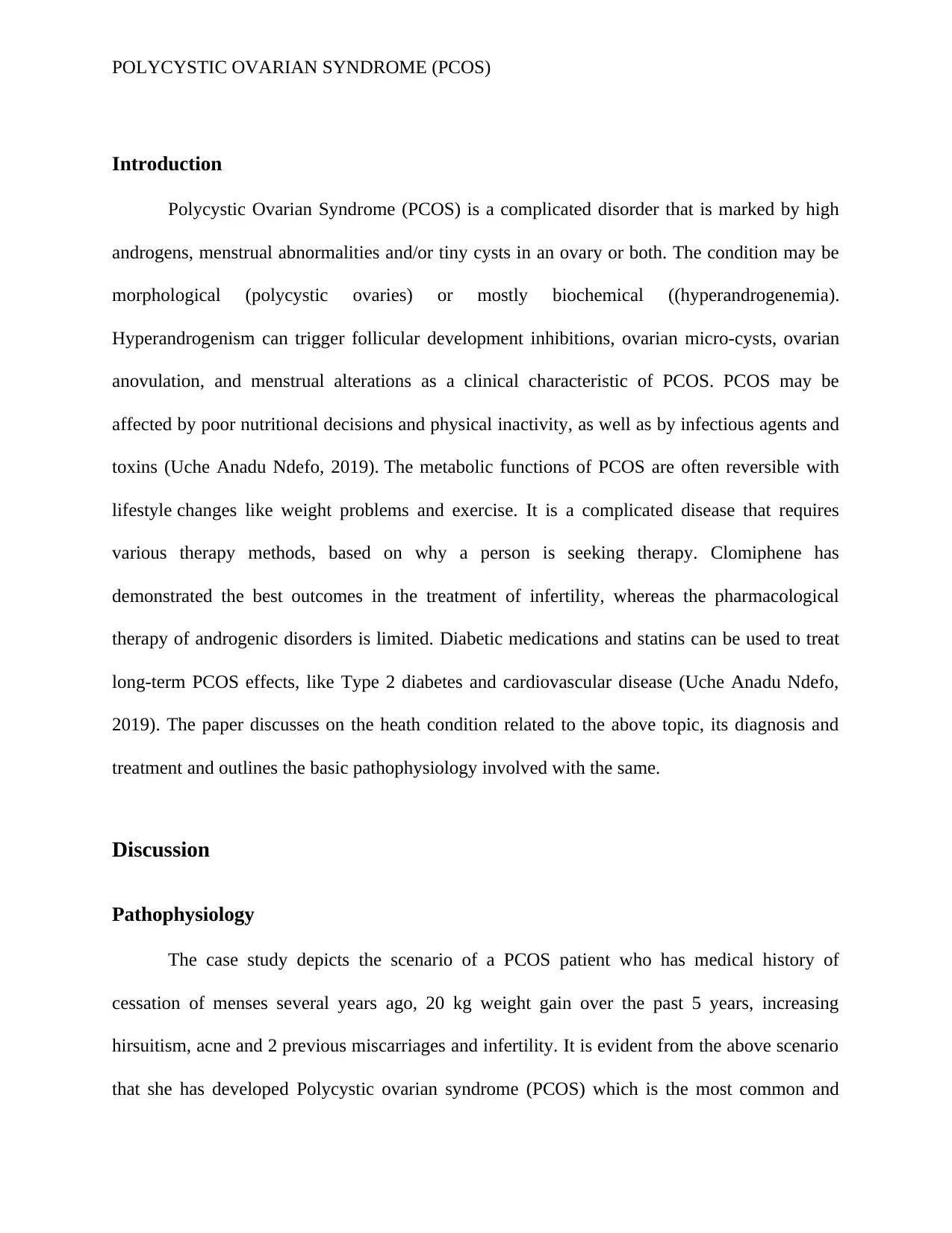
POLYCYSTIC OVARIAN SYNDROME (PCOS)
Introduction
Polycystic Ovarian Syndrome (PCOS) is a complicated disorder that is marked by high
androgens, menstrual abnormalities and/or tiny cysts in an ovary or both. The condition may be
morphological (polycystic ovaries) or mostly biochemical ((hyperandrogenemia).
Hyperandrogenism can trigger follicular development inhibitions, ovarian micro-cysts, ovarian
anovulation, and menstrual alterations as a clinical characteristic of PCOS. PCOS may be
affected by poor nutritional decisions and physical inactivity, as well as by infectious agents and
toxins (Uche Anadu Ndefo, 2019). The metabolic functions of PCOS are often reversible with
lifestyle changes like weight problems and exercise. It is a complicated disease that requires
various therapy methods, based on why a person is seeking therapy. Clomiphene has
demonstrated the best outcomes in the treatment of infertility, whereas the pharmacological
therapy of androgenic disorders is limited. Diabetic medications and statins can be used to treat
long-term PCOS effects, like Type 2 diabetes and cardiovascular disease (Uche Anadu Ndefo,
2019). The paper discusses on the heath condition related to the above topic, its diagnosis and
treatment and outlines the basic pathophysiology involved with the same.
Discussion
Pathophysiology
The case study depicts the scenario of a PCOS patient who has medical history of
cessation of menses several years ago, 20 kg weight gain over the past 5 years, increasing
hirsuitism, acne and 2 previous miscarriages and infertility. It is evident from the above scenario
that she has developed Polycystic ovarian syndrome (PCOS) which is the most common and
Introduction
Polycystic Ovarian Syndrome (PCOS) is a complicated disorder that is marked by high
androgens, menstrual abnormalities and/or tiny cysts in an ovary or both. The condition may be
morphological (polycystic ovaries) or mostly biochemical ((hyperandrogenemia).
Hyperandrogenism can trigger follicular development inhibitions, ovarian micro-cysts, ovarian
anovulation, and menstrual alterations as a clinical characteristic of PCOS. PCOS may be
affected by poor nutritional decisions and physical inactivity, as well as by infectious agents and
toxins (Uche Anadu Ndefo, 2019). The metabolic functions of PCOS are often reversible with
lifestyle changes like weight problems and exercise. It is a complicated disease that requires
various therapy methods, based on why a person is seeking therapy. Clomiphene has
demonstrated the best outcomes in the treatment of infertility, whereas the pharmacological
therapy of androgenic disorders is limited. Diabetic medications and statins can be used to treat
long-term PCOS effects, like Type 2 diabetes and cardiovascular disease (Uche Anadu Ndefo,
2019). The paper discusses on the heath condition related to the above topic, its diagnosis and
treatment and outlines the basic pathophysiology involved with the same.
Discussion
Pathophysiology
The case study depicts the scenario of a PCOS patient who has medical history of
cessation of menses several years ago, 20 kg weight gain over the past 5 years, increasing
hirsuitism, acne and 2 previous miscarriages and infertility. It is evident from the above scenario
that she has developed Polycystic ovarian syndrome (PCOS) which is the most common and
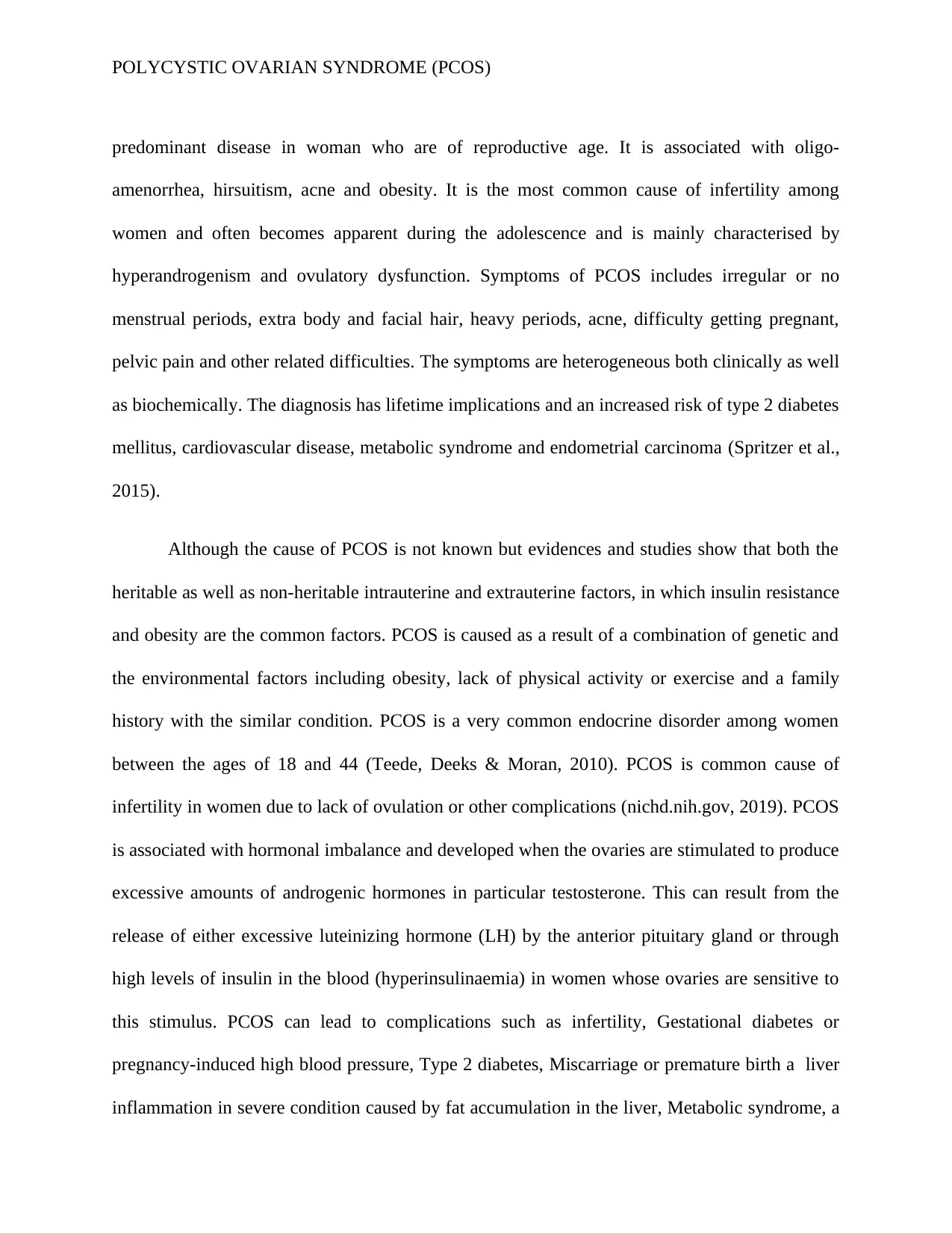
POLYCYSTIC OVARIAN SYNDROME (PCOS)
predominant disease in woman who are of reproductive age. It is associated with oligo-
amenorrhea, hirsuitism, acne and obesity. It is the most common cause of infertility among
women and often becomes apparent during the adolescence and is mainly characterised by
hyperandrogenism and ovulatory dysfunction. Symptoms of PCOS includes irregular or no
menstrual periods, extra body and facial hair, heavy periods, acne, difficulty getting pregnant,
pelvic pain and other related difficulties. The symptoms are heterogeneous both clinically as well
as biochemically. The diagnosis has lifetime implications and an increased risk of type 2 diabetes
mellitus, cardiovascular disease, metabolic syndrome and endometrial carcinoma (Spritzer et al.,
2015).
Although the cause of PCOS is not known but evidences and studies show that both the
heritable as well as non-heritable intrauterine and extrauterine factors, in which insulin resistance
and obesity are the common factors. PCOS is caused as a result of a combination of genetic and
the environmental factors including obesity, lack of physical activity or exercise and a family
history with the similar condition. PCOS is a very common endocrine disorder among women
between the ages of 18 and 44 (Teede, Deeks & Moran, 2010). PCOS is common cause of
infertility in women due to lack of ovulation or other complications (nichd.nih.gov, 2019). PCOS
is associated with hormonal imbalance and developed when the ovaries are stimulated to produce
excessive amounts of androgenic hormones in particular testosterone. This can result from the
release of either excessive luteinizing hormone (LH) by the anterior pituitary gland or through
high levels of insulin in the blood (hyperinsulinaemia) in women whose ovaries are sensitive to
this stimulus. PCOS can lead to complications such as infertility, Gestational diabetes or
pregnancy-induced high blood pressure, Type 2 diabetes, Miscarriage or premature birth a liver
inflammation in severe condition caused by fat accumulation in the liver, Metabolic syndrome, a
predominant disease in woman who are of reproductive age. It is associated with oligo-
amenorrhea, hirsuitism, acne and obesity. It is the most common cause of infertility among
women and often becomes apparent during the adolescence and is mainly characterised by
hyperandrogenism and ovulatory dysfunction. Symptoms of PCOS includes irregular or no
menstrual periods, extra body and facial hair, heavy periods, acne, difficulty getting pregnant,
pelvic pain and other related difficulties. The symptoms are heterogeneous both clinically as well
as biochemically. The diagnosis has lifetime implications and an increased risk of type 2 diabetes
mellitus, cardiovascular disease, metabolic syndrome and endometrial carcinoma (Spritzer et al.,
2015).
Although the cause of PCOS is not known but evidences and studies show that both the
heritable as well as non-heritable intrauterine and extrauterine factors, in which insulin resistance
and obesity are the common factors. PCOS is caused as a result of a combination of genetic and
the environmental factors including obesity, lack of physical activity or exercise and a family
history with the similar condition. PCOS is a very common endocrine disorder among women
between the ages of 18 and 44 (Teede, Deeks & Moran, 2010). PCOS is common cause of
infertility in women due to lack of ovulation or other complications (nichd.nih.gov, 2019). PCOS
is associated with hormonal imbalance and developed when the ovaries are stimulated to produce
excessive amounts of androgenic hormones in particular testosterone. This can result from the
release of either excessive luteinizing hormone (LH) by the anterior pituitary gland or through
high levels of insulin in the blood (hyperinsulinaemia) in women whose ovaries are sensitive to
this stimulus. PCOS can lead to complications such as infertility, Gestational diabetes or
pregnancy-induced high blood pressure, Type 2 diabetes, Miscarriage or premature birth a liver
inflammation in severe condition caused by fat accumulation in the liver, Metabolic syndrome, a
⊘ This is a preview!⊘
Do you want full access?
Subscribe today to unlock all pages.

Trusted by 1+ million students worldwide
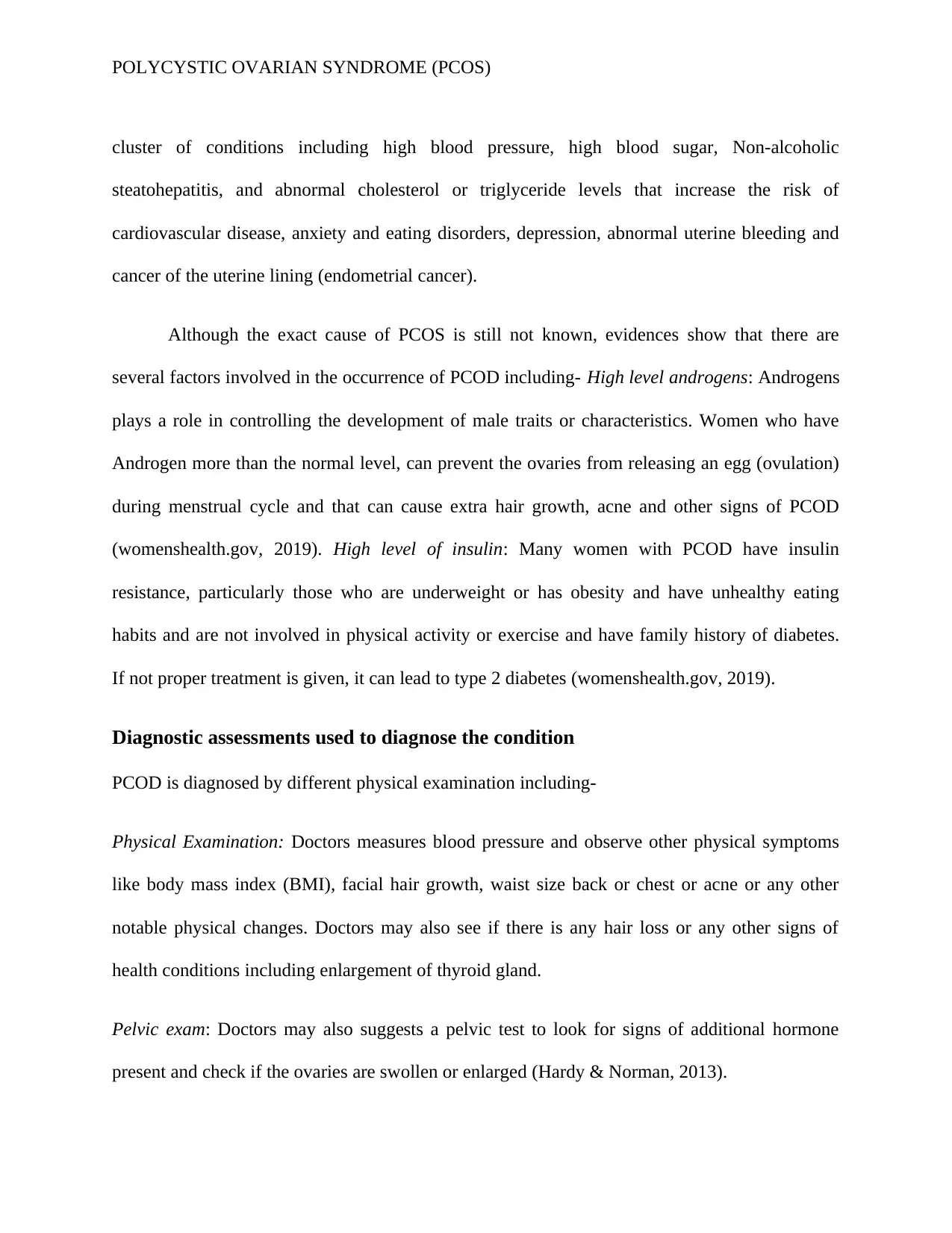
POLYCYSTIC OVARIAN SYNDROME (PCOS)
cluster of conditions including high blood pressure, high blood sugar, Non-alcoholic
steatohepatitis, and abnormal cholesterol or triglyceride levels that increase the risk of
cardiovascular disease, anxiety and eating disorders, depression, abnormal uterine bleeding and
cancer of the uterine lining (endometrial cancer).
Although the exact cause of PCOS is still not known, evidences show that there are
several factors involved in the occurrence of PCOD including- High level androgens: Androgens
plays a role in controlling the development of male traits or characteristics. Women who have
Androgen more than the normal level, can prevent the ovaries from releasing an egg (ovulation)
during menstrual cycle and that can cause extra hair growth, acne and other signs of PCOD
(womenshealth.gov, 2019). High level of insulin: Many women with PCOD have insulin
resistance, particularly those who are underweight or has obesity and have unhealthy eating
habits and are not involved in physical activity or exercise and have family history of diabetes.
If not proper treatment is given, it can lead to type 2 diabetes (womenshealth.gov, 2019).
Diagnostic assessments used to diagnose the condition
PCOD is diagnosed by different physical examination including-
Physical Examination: Doctors measures blood pressure and observe other physical symptoms
like body mass index (BMI), facial hair growth, waist size back or chest or acne or any other
notable physical changes. Doctors may also see if there is any hair loss or any other signs of
health conditions including enlargement of thyroid gland.
Pelvic exam: Doctors may also suggests a pelvic test to look for signs of additional hormone
present and check if the ovaries are swollen or enlarged (Hardy & Norman, 2013).
cluster of conditions including high blood pressure, high blood sugar, Non-alcoholic
steatohepatitis, and abnormal cholesterol or triglyceride levels that increase the risk of
cardiovascular disease, anxiety and eating disorders, depression, abnormal uterine bleeding and
cancer of the uterine lining (endometrial cancer).
Although the exact cause of PCOS is still not known, evidences show that there are
several factors involved in the occurrence of PCOD including- High level androgens: Androgens
plays a role in controlling the development of male traits or characteristics. Women who have
Androgen more than the normal level, can prevent the ovaries from releasing an egg (ovulation)
during menstrual cycle and that can cause extra hair growth, acne and other signs of PCOD
(womenshealth.gov, 2019). High level of insulin: Many women with PCOD have insulin
resistance, particularly those who are underweight or has obesity and have unhealthy eating
habits and are not involved in physical activity or exercise and have family history of diabetes.
If not proper treatment is given, it can lead to type 2 diabetes (womenshealth.gov, 2019).
Diagnostic assessments used to diagnose the condition
PCOD is diagnosed by different physical examination including-
Physical Examination: Doctors measures blood pressure and observe other physical symptoms
like body mass index (BMI), facial hair growth, waist size back or chest or acne or any other
notable physical changes. Doctors may also see if there is any hair loss or any other signs of
health conditions including enlargement of thyroid gland.
Pelvic exam: Doctors may also suggests a pelvic test to look for signs of additional hormone
present and check if the ovaries are swollen or enlarged (Hardy & Norman, 2013).
Paraphrase This Document
Need a fresh take? Get an instant paraphrase of this document with our AI Paraphraser
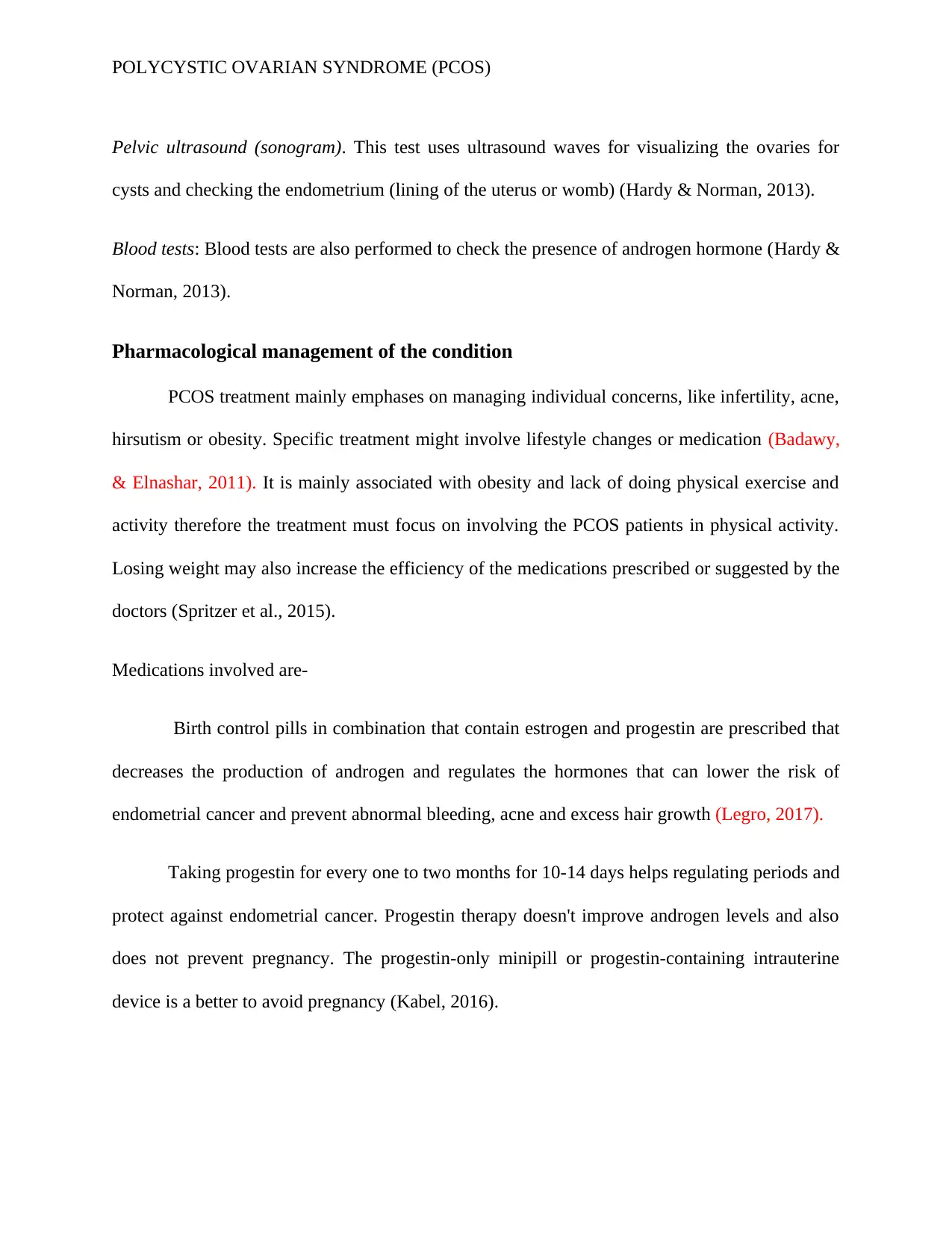
POLYCYSTIC OVARIAN SYNDROME (PCOS)
Pelvic ultrasound (sonogram). This test uses ultrasound waves for visualizing the ovaries for
cysts and checking the endometrium (lining of the uterus or womb) (Hardy & Norman, 2013).
Blood tests: Blood tests are also performed to check the presence of androgen hormone (Hardy &
Norman, 2013).
Pharmacological management of the condition
PCOS treatment mainly emphases on managing individual concerns, like infertility, acne,
hirsutism or obesity. Specific treatment might involve lifestyle changes or medication (Badawy,
& Elnashar, 2011). It is mainly associated with obesity and lack of doing physical exercise and
activity therefore the treatment must focus on involving the PCOS patients in physical activity.
Losing weight may also increase the efficiency of the medications prescribed or suggested by the
doctors (Spritzer et al., 2015).
Medications involved are-
Birth control pills in combination that contain estrogen and progestin are prescribed that
decreases the production of androgen and regulates the hormones that can lower the risk of
endometrial cancer and prevent abnormal bleeding, acne and excess hair growth (Legro, 2017).
Taking progestin for every one to two months for 10-14 days helps regulating periods and
protect against endometrial cancer. Progestin therapy doesn't improve androgen levels and also
does not prevent pregnancy. The progestin-only minipill or progestin-containing intrauterine
device is a better to avoid pregnancy (Kabel, 2016).
Pelvic ultrasound (sonogram). This test uses ultrasound waves for visualizing the ovaries for
cysts and checking the endometrium (lining of the uterus or womb) (Hardy & Norman, 2013).
Blood tests: Blood tests are also performed to check the presence of androgen hormone (Hardy &
Norman, 2013).
Pharmacological management of the condition
PCOS treatment mainly emphases on managing individual concerns, like infertility, acne,
hirsutism or obesity. Specific treatment might involve lifestyle changes or medication (Badawy,
& Elnashar, 2011). It is mainly associated with obesity and lack of doing physical exercise and
activity therefore the treatment must focus on involving the PCOS patients in physical activity.
Losing weight may also increase the efficiency of the medications prescribed or suggested by the
doctors (Spritzer et al., 2015).
Medications involved are-
Birth control pills in combination that contain estrogen and progestin are prescribed that
decreases the production of androgen and regulates the hormones that can lower the risk of
endometrial cancer and prevent abnormal bleeding, acne and excess hair growth (Legro, 2017).
Taking progestin for every one to two months for 10-14 days helps regulating periods and
protect against endometrial cancer. Progestin therapy doesn't improve androgen levels and also
does not prevent pregnancy. The progestin-only minipill or progestin-containing intrauterine
device is a better to avoid pregnancy (Kabel, 2016).
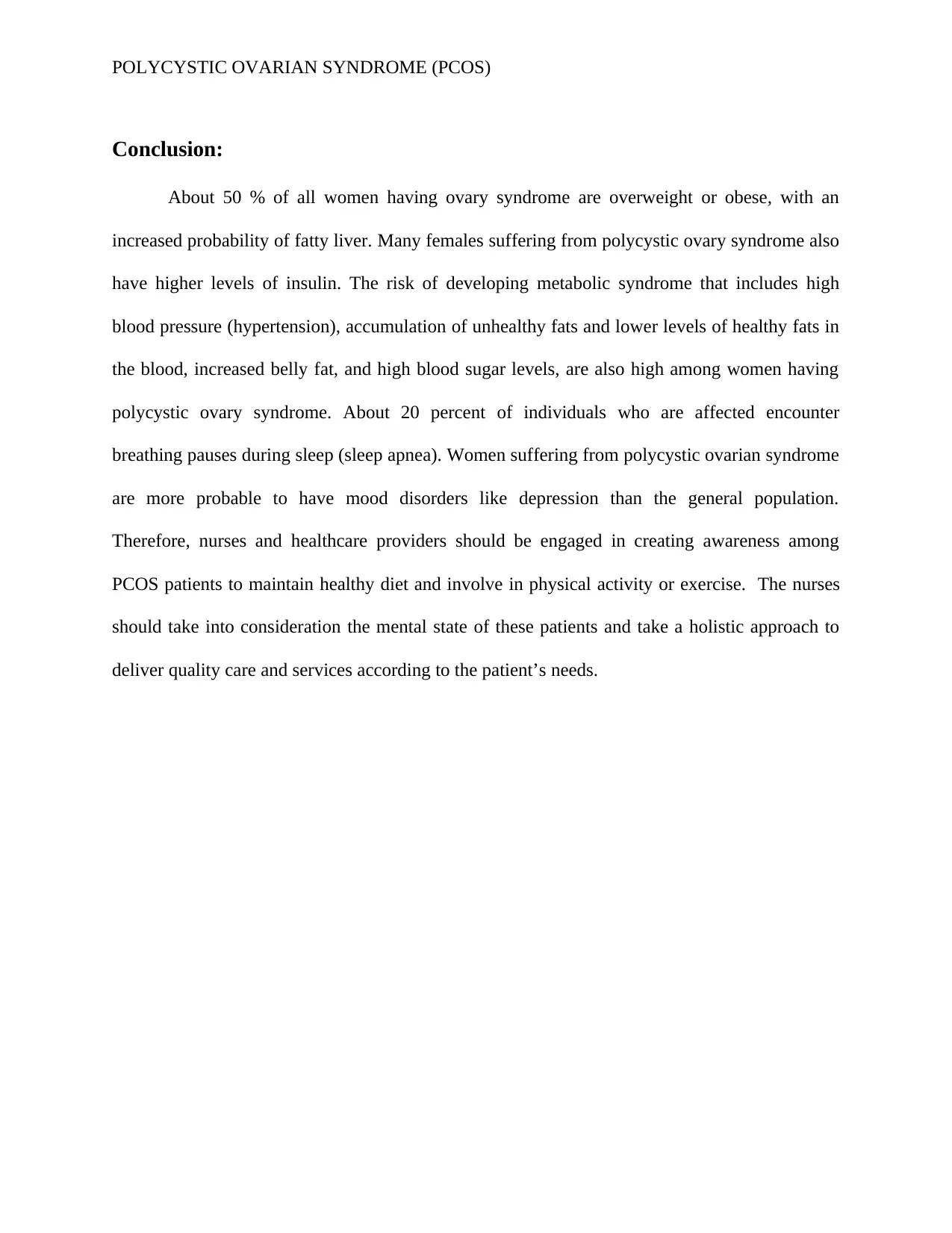
POLYCYSTIC OVARIAN SYNDROME (PCOS)
Conclusion:
About 50 % of all women having ovary syndrome are overweight or obese, with an
increased probability of fatty liver. Many females suffering from polycystic ovary syndrome also
have higher levels of insulin. The risk of developing metabolic syndrome that includes high
blood pressure (hypertension), accumulation of unhealthy fats and lower levels of healthy fats in
the blood, increased belly fat, and high blood sugar levels, are also high among women having
polycystic ovary syndrome. About 20 percent of individuals who are affected encounter
breathing pauses during sleep (sleep apnea). Women suffering from polycystic ovarian syndrome
are more probable to have mood disorders like depression than the general population.
Therefore, nurses and healthcare providers should be engaged in creating awareness among
PCOS patients to maintain healthy diet and involve in physical activity or exercise. The nurses
should take into consideration the mental state of these patients and take a holistic approach to
deliver quality care and services according to the patient’s needs.
Conclusion:
About 50 % of all women having ovary syndrome are overweight or obese, with an
increased probability of fatty liver. Many females suffering from polycystic ovary syndrome also
have higher levels of insulin. The risk of developing metabolic syndrome that includes high
blood pressure (hypertension), accumulation of unhealthy fats and lower levels of healthy fats in
the blood, increased belly fat, and high blood sugar levels, are also high among women having
polycystic ovary syndrome. About 20 percent of individuals who are affected encounter
breathing pauses during sleep (sleep apnea). Women suffering from polycystic ovarian syndrome
are more probable to have mood disorders like depression than the general population.
Therefore, nurses and healthcare providers should be engaged in creating awareness among
PCOS patients to maintain healthy diet and involve in physical activity or exercise. The nurses
should take into consideration the mental state of these patients and take a holistic approach to
deliver quality care and services according to the patient’s needs.
⊘ This is a preview!⊘
Do you want full access?
Subscribe today to unlock all pages.

Trusted by 1+ million students worldwide
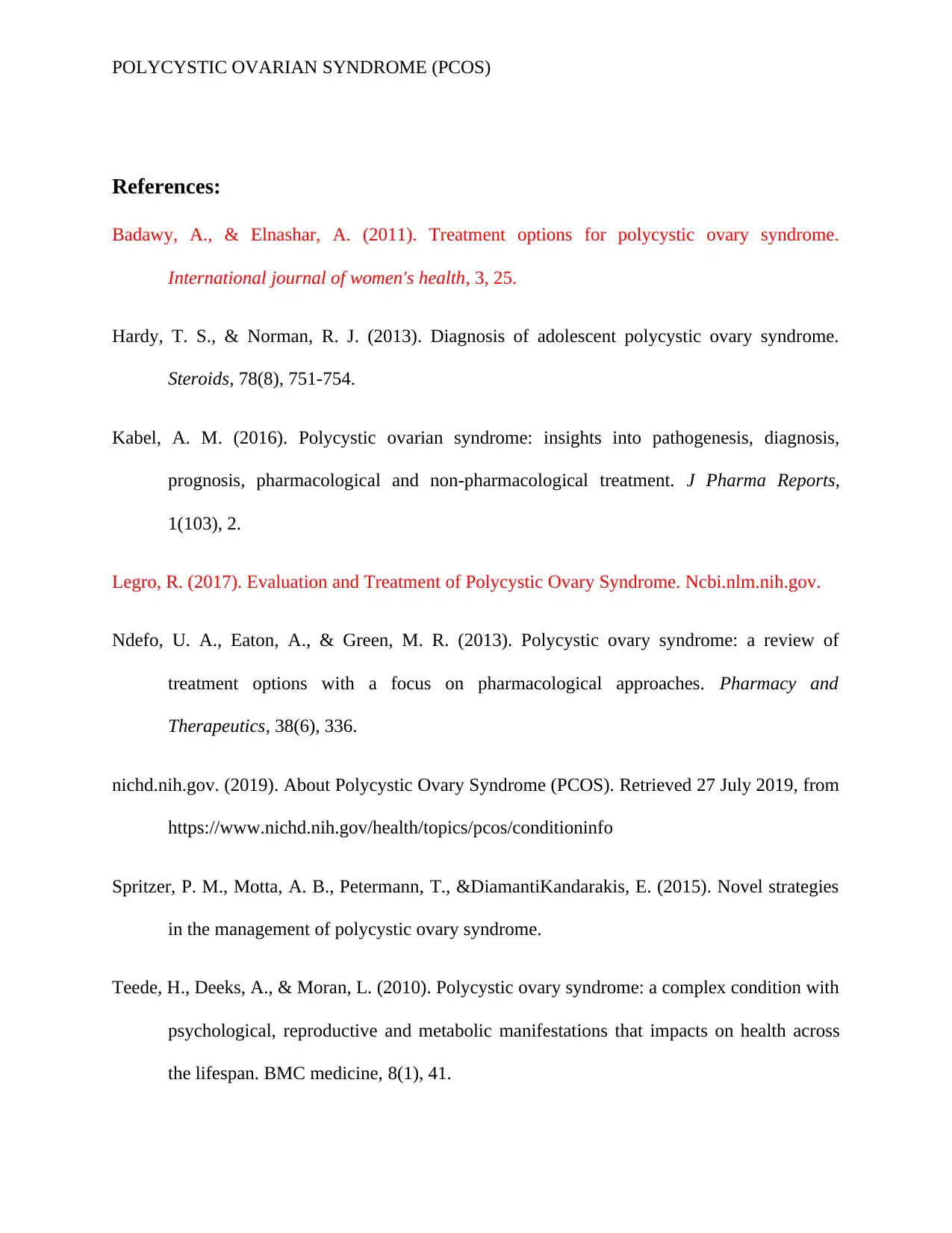
POLYCYSTIC OVARIAN SYNDROME (PCOS)
References:
Badawy, A., & Elnashar, A. (2011). Treatment options for polycystic ovary syndrome.
International journal of women's health, 3, 25.
Hardy, T. S., & Norman, R. J. (2013). Diagnosis of adolescent polycystic ovary syndrome.
Steroids, 78(8), 751-754.
Kabel, A. M. (2016). Polycystic ovarian syndrome: insights into pathogenesis, diagnosis,
prognosis, pharmacological and non-pharmacological treatment. J Pharma Reports,
1(103), 2.
Legro, R. (2017). Evaluation and Treatment of Polycystic Ovary Syndrome. Ncbi.nlm.nih.gov.
Ndefo, U. A., Eaton, A., & Green, M. R. (2013). Polycystic ovary syndrome: a review of
treatment options with a focus on pharmacological approaches. Pharmacy and
Therapeutics, 38(6), 336.
nichd.nih.gov. (2019). About Polycystic Ovary Syndrome (PCOS). Retrieved 27 July 2019, from
https://www.nichd.nih.gov/health/topics/pcos/conditioninfo
Spritzer, P. M., Motta, A. B., Petermann, T., &DiamantiKandarakis, E. (2015). Novel strategies
in the management of polycystic ovary syndrome.
Teede, H., Deeks, A., & Moran, L. (2010). Polycystic ovary syndrome: a complex condition with
psychological, reproductive and metabolic manifestations that impacts on health across
the lifespan. BMC medicine, 8(1), 41.
References:
Badawy, A., & Elnashar, A. (2011). Treatment options for polycystic ovary syndrome.
International journal of women's health, 3, 25.
Hardy, T. S., & Norman, R. J. (2013). Diagnosis of adolescent polycystic ovary syndrome.
Steroids, 78(8), 751-754.
Kabel, A. M. (2016). Polycystic ovarian syndrome: insights into pathogenesis, diagnosis,
prognosis, pharmacological and non-pharmacological treatment. J Pharma Reports,
1(103), 2.
Legro, R. (2017). Evaluation and Treatment of Polycystic Ovary Syndrome. Ncbi.nlm.nih.gov.
Ndefo, U. A., Eaton, A., & Green, M. R. (2013). Polycystic ovary syndrome: a review of
treatment options with a focus on pharmacological approaches. Pharmacy and
Therapeutics, 38(6), 336.
nichd.nih.gov. (2019). About Polycystic Ovary Syndrome (PCOS). Retrieved 27 July 2019, from
https://www.nichd.nih.gov/health/topics/pcos/conditioninfo
Spritzer, P. M., Motta, A. B., Petermann, T., &DiamantiKandarakis, E. (2015). Novel strategies
in the management of polycystic ovary syndrome.
Teede, H., Deeks, A., & Moran, L. (2010). Polycystic ovary syndrome: a complex condition with
psychological, reproductive and metabolic manifestations that impacts on health across
the lifespan. BMC medicine, 8(1), 41.
Paraphrase This Document
Need a fresh take? Get an instant paraphrase of this document with our AI Paraphraser
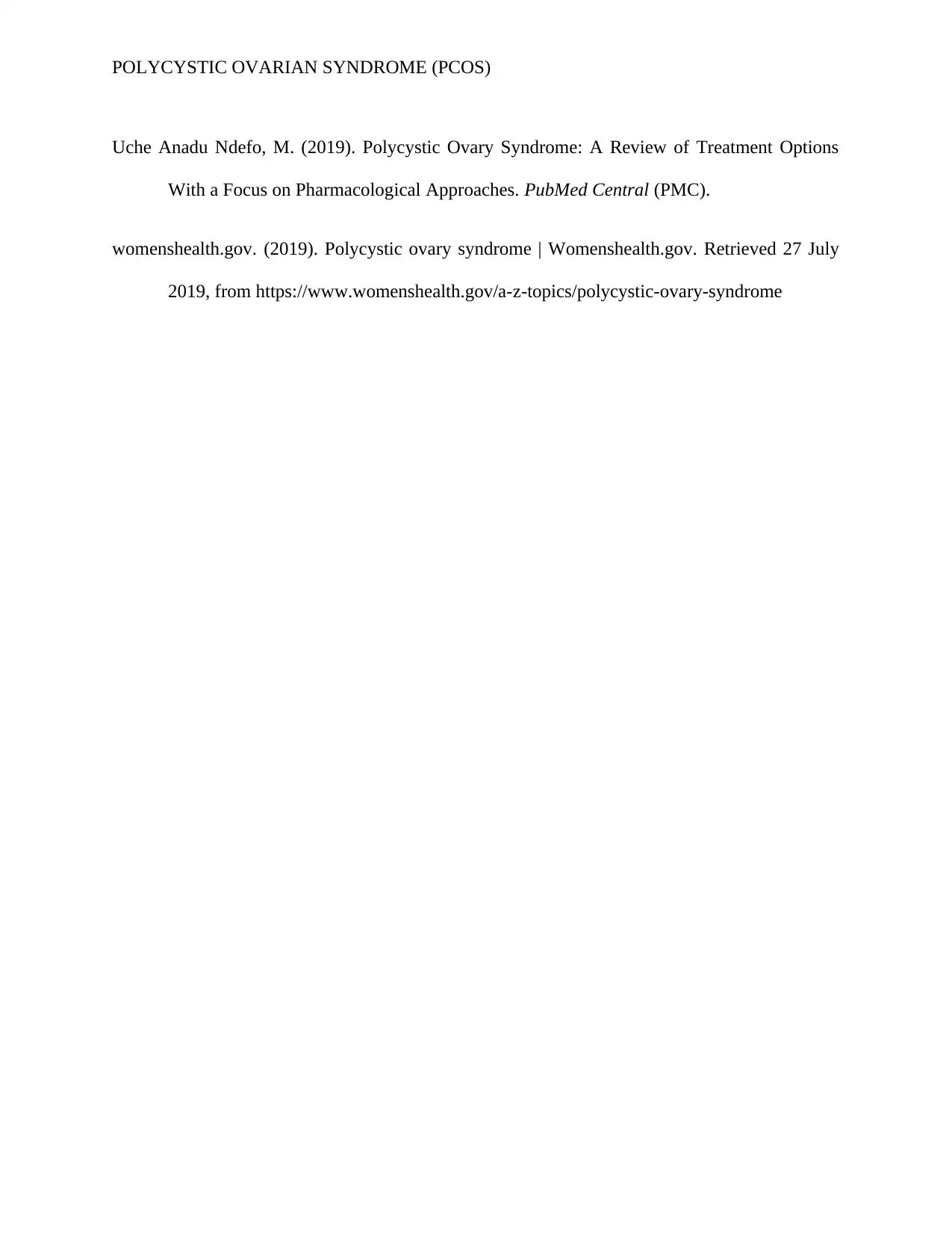
POLYCYSTIC OVARIAN SYNDROME (PCOS)
Uche Anadu Ndefo, M. (2019). Polycystic Ovary Syndrome: A Review of Treatment Options
With a Focus on Pharmacological Approaches. PubMed Central (PMC).
womenshealth.gov. (2019). Polycystic ovary syndrome | Womenshealth.gov. Retrieved 27 July
2019, from https://www.womenshealth.gov/a-z-topics/polycystic-ovary-syndrome
Uche Anadu Ndefo, M. (2019). Polycystic Ovary Syndrome: A Review of Treatment Options
With a Focus on Pharmacological Approaches. PubMed Central (PMC).
womenshealth.gov. (2019). Polycystic ovary syndrome | Womenshealth.gov. Retrieved 27 July
2019, from https://www.womenshealth.gov/a-z-topics/polycystic-ovary-syndrome
1 out of 8
Related Documents
Your All-in-One AI-Powered Toolkit for Academic Success.
+13062052269
info@desklib.com
Available 24*7 on WhatsApp / Email
![[object Object]](/_next/static/media/star-bottom.7253800d.svg)
Unlock your academic potential
Copyright © 2020–2025 A2Z Services. All Rights Reserved. Developed and managed by ZUCOL.





